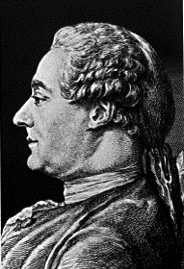| Profile | Major Works | Resources |
Étienne Bonnot, Abbé de Condillac, 1714-1780.

Étienne Bonnot de Condillac, Abbé de Mureaux, was a French cleric, Enlightenment philosopher and logician. He was the younger brother of Abbé de Mably.
Born in Grenoble (Dauphinois), to a wealthy family of lawyers, recently risen to noblesse du robe, surnamed "Bonnot de Mably", after their properties in Mably (in the Lyonnais region of the Loire). While the eldest brother Jean Bonnot de Mably pursued a political legal career in Lyons, the two younger brothers Gabriel and Étienne, pursued clerical careers. To differentiate him from his brother, Étienne was surnamed "Bonnot de Condillac" (after another family property).
Condillac's early years are unclear. A sickly child, he did not attend school and only learned to read at the late age of twelve. He eventually enrolled at a local Jesuit school in his late teens, and went on to study in the seminary of Saint-Sulpice in Paris. He was ordained into the Catholic priesthood in 1740. However much a sincere cleric, Condillac was never much inclined to his priestly duties. His benefice from the abbey of Mureaux, gave him sufficient income and leisure to focus on his passion for philosophy and science.
Condillac was particularly enthralled by the English scientific-empirical tradition, in particular the works of Newton and Locke. His first treatise (Essai,1746) was essentially a popularization of Locke's ideas. This was followed up by his 1749 Traité des systemes, an attack on the speculative rationalist French tradition, in favor of British empiricism, which was explosive in French intellectual circles. In his 1754 Traité des sensations, Condillac made his most significant philosophical contribution to that tradition, refusing Locke's distinction between sensations (from outer sense) and reflection (from inner sense. Condillac argued that external impressions through the outer senses can account for all ideas and all mental operations.
Condillac moved in the circle of the French Enlightenment philosophes. He struck up an early friendship with Rousseau, when the latter was tutor to the family of his older brother Jean Bonnot, and Rousseau introduced him Diderot and the rest of the luminaries - Voltaire, d'Alembert, Helvetius, etc. His 1749 treatise was his calling card, and very influential on the Encyclopèdie, in which he was an early assistant editor.
Condillac's philosophical career in France was interrupted by his appointment, in 1757, as tutor to the young Ferdinand Duke of Parma (grandson of king Louis XV of France), which forced him to move to Italy, and ate up much of his time. He later published his tutor notes as the monumental 13-volume Cours d'études. Condillac returned to France in 1768, where he was promptly elected to the Académie française. However, finding the increasingly irreligious atmosphere among the philosophers of Versailles and Paris a bit too much to bear, Condillac withdrew to the quiet seclusion of his country estates, turning down offers of official positions in the royal court.
It was during this retirement that Condillac composed his main economic work (1776). It was remarkably prescient in his conception of interacting markets and competition. Following up on Galiani, he developed a utility-cum-scarcity theory of value that anticipates the Marginalist Revolution by a century. For Condillac, value depends on the utility of a commodity in relation to the subjective needs of those who use it, increasing or decreasing as these needs become more or less intense. Condillac connected these variations with the degree of scarcity. In his words:
"Value is not an attribute of matter, but represents our sense of its usefulness and this utility is relative to our need. It grows or diminishes according as our need expands or contracts. But since the value of things is based upon need, it is natural that a more keenly felt need should endow things with a greater value, while a less urgent need endows them with less. Value increases with scarcity and diminishes with plenty." (Condillac, 1776: Ch. I, Pt.1)
Condillac's work has some parallels with the contemporary Physiocrats, it differed from them significantly in his unconditional rejection of the land theory of value, and insistence on a utility-determined "true price" ("vraix prix") as the basis of rational allocation. But his work did not have polemics with Physiocrats in mind. He embeds it in a speculative history of economic development, explaining how economies go through phases of "progress" (characterized by rational allocation via "true prices" discovered by the market process) and "decline" (characterized by misallocation, brought about by the misbehavior of the aristocracy and crown, interfering in markets and introducing distortionary "false prices"). Condillac's treatise coincidentally came out in the same year as Adam Smith's Wealth in Nations, but it is not a coincidence that both expounded a similar laissez faire view of markets.
Condillac's theories -- in economics, philosophy and psychology -- were taken up by Destutt de Tracy and (less faithfully) by Jean-Baptiste Say, so can be regarded as one of the kernels of the French Liberal School. A century later, William Stanley Jevons would laud Condillac's "charming philosophic work" as "perhaps the earliest distinct statement of the true connection between value and utility" (Jevons, TPE, 1879 ed, p.xxx). Condillac's economic contributions had remained largely unknown to English-speaking writers until highlighted by H.D. MacLeod in 1863.
|
Major Works of Etienne Bonnot de Condillac
|
|
HET
|
|
Resources on Etienne de Condillac
|
All rights reserved, Gonçalo L. Fonseca
